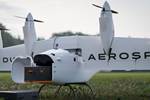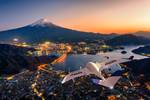Production-ready Dufour Aero2 drone undergoes hover flight
The composites-intensive VTOL platform is next expected to undergo a series of test flights in various conditions to validate its performance, safety and reliability, leading up to eventual certification.
The Aero2, a tilt-wing drone developed by Dufour Aerospace (Zurich, Switzerland), has completed its first successful hover flight. The aircraft platform version — called the “X2.3” — is one of many prototypes that have been put through their paces, demonstrating the capabilities of Dufour’s vision and platform. X2.3 however is reported to be the first hovering flight achieved using a production-ready design.
The Aero2’s main propeller is equipped with carbon fiber fixed-pitch propeller blades. Its airframe, structural components in the nacelles and tail, composite connectors and even its brackets are also made from composite materials.
“This achievement is the result of years of research, development and testing by our team,” says Sascha Hardegger, CEO of Dufour Aerospace. “From those first prototype versions to this aircraft that will very soon be ready to be flown by eVTOL [electric vertical takeoff and landing] and drone operators, we believe the market eagerly awaits our progress.”
The X2.3’s successful hover flight demonstrates the viability of the aircraft’s design and its advanced flight control systems. This flight test, conducted under rigorous safety protocols, showcased the stability, control, and precision of the Aero2 in a hover state, a critical capability for any VTOL aircraft.
The Aero2 X2.3 is part of Dufour Aerospace’s vision to create VTOL tilt-wing aircraft that combine the benefits of traditional fixed-wing airplanes with the versatility of helicopters and, ultimately, in an fully automated manner. The Aero2 is designed to perform a variety of long-range missions, critical cargo transport, support of medical supply chains including organ transportation, and surveillance, making it a versatile platform for commercial and defense applications.
Each milestone in the Aero2 development program brings the company closer to the eventual goal of full operational capability. Following this flight, Dufour Aerospace will continue to rigorously test and refine the aircraft. The next phases of testing include transitioning from hover to forward flight, a complex maneuver that is crucial for demonstrating the aircraft’s full operational capabilities. The Dufour team has been building up to this phase, with expectations to certify the production aircraft in due course.
Related Content
-
Infinite Composites: Type V tanks for space, hydrogen, automotive and more
After a decade of proving its linerless, weight-saving composite tanks with NASA and more than 30 aerospace companies, this CryoSphere pioneer is scaling for growth in commercial space and sustainable transportation on Earth.
-
The lessons behind OceanGate
Carbon fiber composites faced much criticism in the wake of the OceanGate submersible accident. CW’s publisher Jeff Sloan explains that it’s not that simple.
-
Plant tour: Joby Aviation, Marina, Calif., U.S.
As the advanced air mobility market begins to take shape, market leader Joby Aviation works to industrialize composites manufacturing for its first-generation, composites-intensive, all-electric air taxi.
















